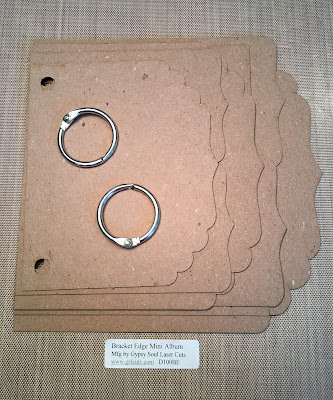Hello crafty friends! I have a civic-minded shadow box with you. While we were clearing out the attic the other day Husband found a 70s-era patch that set the tone for this weeks project using the
Arch Top Cabinet w/Doors (and feet -- really great feet) from
Gypsy Soul Laser Cuts.
You'll see the patch at the bottom of the post. For now, let me walk you through my construction. Remember my crafty education team motto? "I make the mistakes so you don't have to!"
Here all the parts laid out. The dimensions when finished are 4" x 1 1/2" x 6 1/2" (10.16cm x 3.81cm x 16.51cm).
The first thing I did was to outline the body on my chosen paper. I like to score corners rather than cut separate panels, but you can do that, too. If you do one big piece like mine, leave extra on the side flaps to account for the corners. See how there's more on the left edge (and barely more on the right)? That's what I mean AND what you see here was barely enough. While it's flat, outline the base arches, moving the left and right panels out a little first ( accounting for that scored corner). Set this aside and do the same for the doors and front panel.

I picked out door knobs and poked a hole in the first door. To match the second door, I laid the first onto the second and marked where the hole needed to be. These doors are marked "front" and "back" in pencil, and -- even though you can't really see there are two doors here, they are stacked front-to-back-to-back-to-front. It doesn't matter as much at this stage, but if paper or paint had already applied, I can guarantee I would have something upside down. ::shrug::
I now have all my outer papers cut. Notice I've penciled in the base arches but not cut. I glued the top and bottom then the sides, and let it sit for a while.
Score the paper where you think the corners are. This sounds scary, but you can score a little to the left or right of the original score lines if needed. I had to adjust both and it didn't make a difference in the finished appearance.
Once the cabinet is dry enough to handle, double check the paper width before cutting out the base. This is where I needed to adjust my score lines. Cut out the center arch first, then check your pencil lines on the side arches and adjust as needed. Once your arches are cut out, go ahead and glue the paper to the cabinet, starting with one side and wrapping around, making sure to flatten the paper as you go. I like to use Mod Podge for these kinds of steps since it briefly allows me to nudge the paper a little if needed.
At this point leave the doors and front alone.
I applied black gesso to the inside, base, and top. Later I painted the top outside and bottom outside with a mottled brown-black-red combo to mimic the door paper.
I used linen hinge tape to attach the doors to the frame. I put as much as possible on the narrow frame and marked the spot.
Next I separated the tape from the backing and stuck it the the door; I reattached the backing to the little flap as I worked on the red door panel.
I don't have photos, but here's what I did: sanded the left edge of the paper at an angle to account for the hinging. This was easier to do before attaching to the door because I didn't want to sand the linen tape. I did the same for the right door, then attached the paper to the door panel. I sanded the rest of the edges a bit and then inked all around.
Here is what it looked like at this stage. Notice the doors fall in a bit - at the end I made door stops from the little dashes left from the laser cutting. (I keep all of these "just in case"). In the future I'll add the door stops before the front panel is attached so they can be better aligned.
I let it dry overnight with the doors open. The next day I sanded all the edges (and reinked as needed), then decorated.
Thanks for your visit today. Please vote in your local elections as well as the big ones!
Cheers,
Susan
Gypsy Soul Laser Cuts Used
Arch Top Cabinet with Doors #D11B
Other Supplies Used
Tim Holtz Seasonal paper
Brown Dresden trim
Acrylic paints
Black gesso
Mod Podge
TH metal door knobs
Vintage photo
1970s fabric patch
Cheese cloth
Vintage brooch
Lineco Linen Hinge Tape



























































